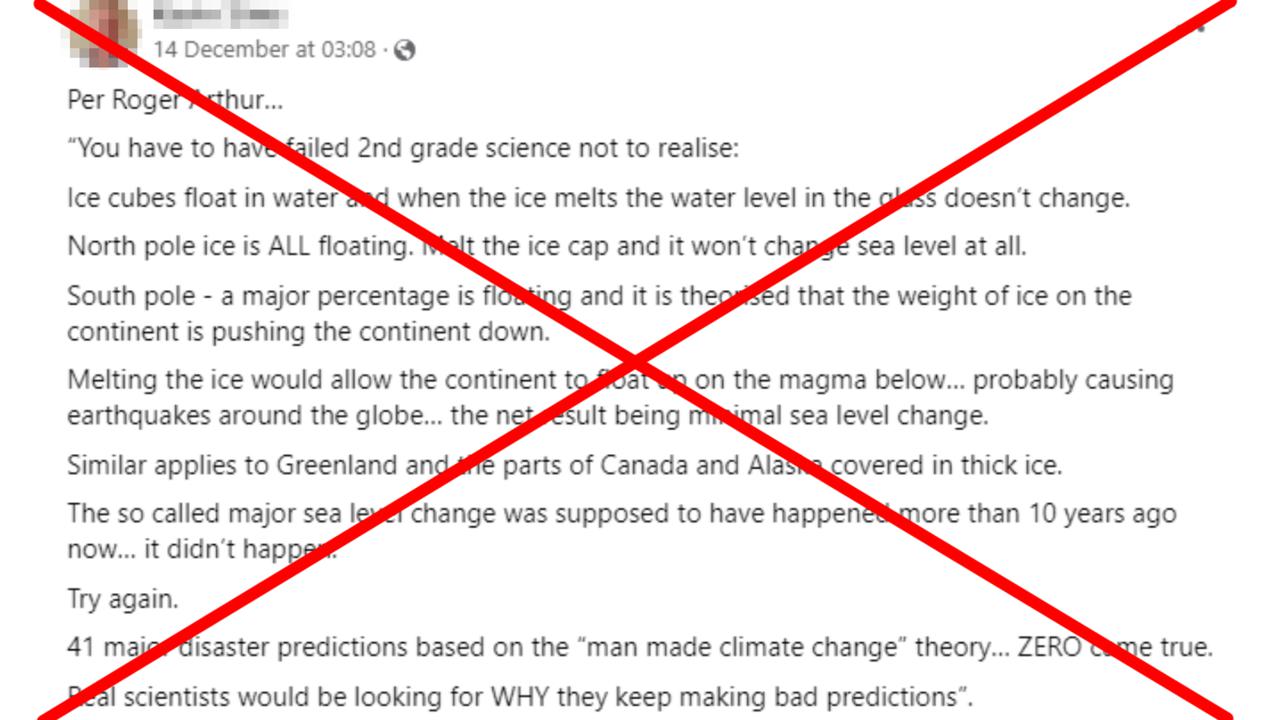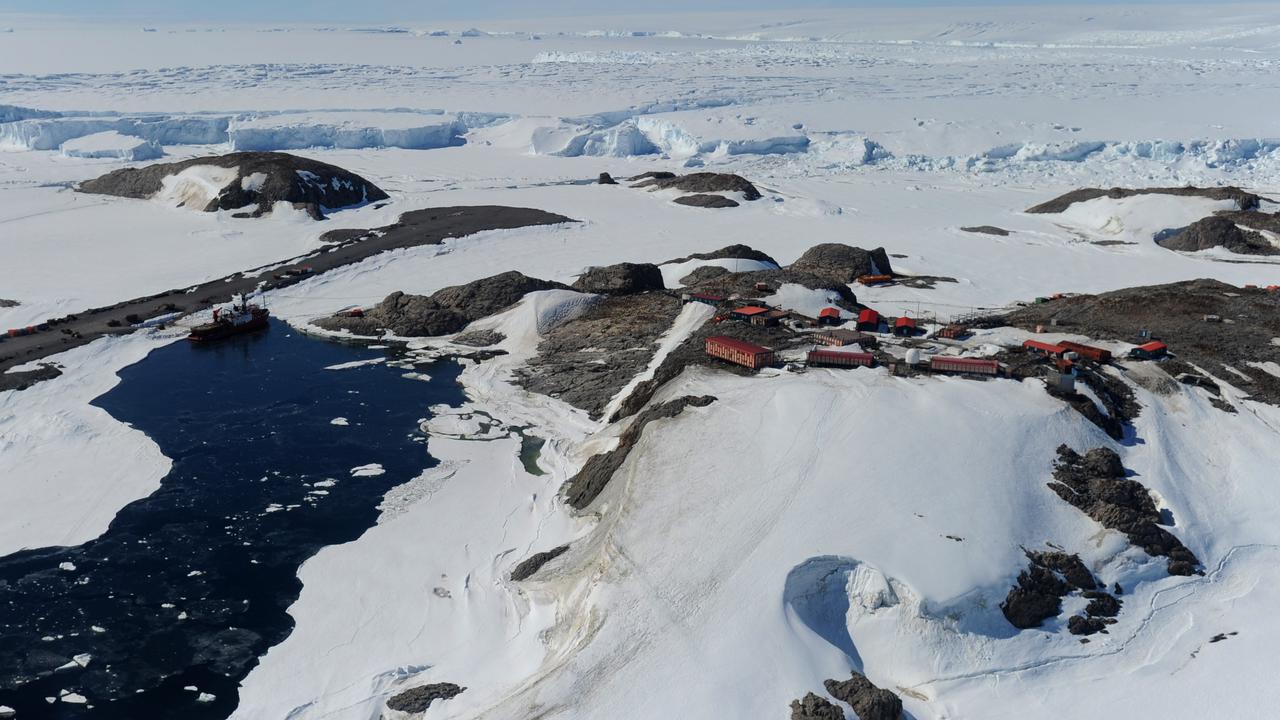WHAT WAS CLAIMED
The melting of South Pole ice will allow the continent to float up, therefore resulting in minimal sea level change.
OUR VERDICT
False. The process (isostatic rebound) does not increase the volume of the ocean basin. Meanwhile, melting land ice directly adds water to the oceans.
A Facebook post has claimed the melting of South Pole ice will result in minimal sea level change.
The post (archived here) suggests this is for two reasons. Firstly, a "major percentage" of the ice is already floating sea ice. Secondly, melting land ice will allow the continent to "float up".
The claim is false. Most of Antarctic ice is land ice, not floating sea ice. Additionally, experts told AAP FactCheck the process by which land floats up after ice mass is released does not increase the volume of the ocean basin.
The Antarctic Ice Sheet holds about 90 per cent of all freshwater on the planet, with predictions global sea levels could rise by up to 60 metres if it melts.
The post made on a climate sceptics group page, claims melting polar ice barely impacts sea levels.
"Ice cubes float in water and when the ice melts the water level in the glass doesn't change. North pole ice is ALL floating. Melt the ice cap and it won't change sea level at all. South pole - a major percentage is floating and it is theorised that the weight of ice on the continent is pushing the continent down," the post states.

The Facebook user refers to the South Pole, which is a precise point on the earth's surface, not a geographical mass. He likely means the Antarctic.
The frozen continent is made up of two forms of ice: land ice and sea ice. Sea ice is frozen ocean water that floats, whereas land ice is composed of a gradual accumulation of snow on land.
Experts told AAP FactCheck while it's true that melting sea ice does not increase sea levels, the melting of ice sheets on land does.
Alex Sen Gupta, an associate professor at UNSW Sydney and chief investigator at the Australian Centre of Excellence for Antarctic Science (ACEAS), called the post's claim nonsense.
"The melting of floating ice, as occurs over the Arctic Ocean and around Antarctica in the Southern Ocean, does not cause sea levels to rise. No climate scientist has claimed it does," he said in an email.
"However, the melting of ice on land in glaciers and ice sheets on Greenland and Antarctica does lead to sea level rise (it's just like pouring water into a bath tub)."

The post states "a major percentage" of Antarctic ice is floating sea ice - therefore its melting would not add to sea level rise.
Matt King, a professor of polar geodesy at the University of Tasmania and director of ACEAS, told AAP FactCheck this is false.
"The land ice area is about 12.3 million square kilometres, with its floating extension, known as ice shelves, about another 1.6 million square kilometres," he said via email. "So the land ice is almost 10 times larger in area than its floating extension. The ice shelves have an important role to play, but not in sea level. The focus is the vast area of ice on land.
"Antarctic land ice is being lost into the ocean at a rate of about 150 billion tonnes per year, over and above what is being replaced by snowfall."
The same thing is happening in other ice-laden regions.
"The ice of the Greenland Ice Sheet is largely based on land, unlike the sea ice at the North Pole, and over the recent decade has been adding about 280 billion tonnes per year to sea levels," Prof King added.
"Smaller glaciers surrounding the Arctic, like in Canada or the Russian Arctic are, with few exceptions, thinning and adding to sea levels."

The Facebook post also attempts to dismiss worries about land ice.
"The weight of the ice on the continent is pushing the continent down. Melting the ice would allow the continent to float up on the magma below… probably causing earthquakes around the globe… the net result being minimal sea level change," it states.
Prof King called this a "red herring".
When land ice melts, it prompts the ground underneath to slowly rise - a process called isostatic rebound.
Rather than increase the volume of the ocean basin, Prof King said it is believed to reduce the basin, "like squeezing the sides of a plastic drink cup".
As a result it is thought to actually increase global mean sea levels, he added.
The reverse process of isostatic rebound - when increasing ice pushes land mass down - is called bedrock depression.
Ian Simmonds, a professor in the School of Earth sciences at The University of Melbourne, said both processes do not increase the volume of ocean basins as "the mass/volume of the earth's mantle does not change".
Prof Simmonds said the isostatic rebound from the last ice age was still ongoing in parts of Scandinavia.
He added: "So, in short, the melting of ice caps gives an almost-immediate response to sea level while bedrock responses, even if they were relevant (which they are not!), would only become apparent 10,000 years later."
Globally, sea levels have risen 160mm-210mm over the past 100 years.
AAP FactCheck has debunked numerous claims related to Antarctica and climate change (see here, here and here).
The Verdict
The claim that the melting of South Pole ice will allow the continent to float up, therefore resulting in minimal sea level change is false.
While melting land ice will allow the continent to slowly rise, it will not increase the volume of the ocean basin. Even if it did, the process takes many thousands of years whereas melting land ice instantly adds to the volume of water in the oceans. Additionally, the Antarctic does not have a 'major percentage' of floating ice.
False - The claim is inaccurate.
AAP FactCheck is an accredited member of the International Fact-Checking Network. To keep up with our latest fact checks, follow us on Facebook, Twitter and Instagram.












